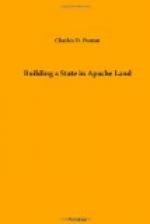“At Yuma, on the Colorado River, the only attempt at irrigation so far made is by pumping works, which raise the water from the river and convey it in pipes to the lands to be watered. While thus far only a limited area is watered by this method, the results are satisfactory, and the expense no greater than in many of the pipe systems of California.
“But for the magnitude, scope, and the boldness of its purpose, the project to irrigate the great Colorado Desert is without a parallel in the arid West, if in the world.
“This undertaking contemplates the construction of gravity canals from a point in the Colorado River, several miles above Yuma, and the conducting of the waters of this river over an arid waste, that, while forbidding in appearance, is known to be capable of great fertility. One interesting feature of this plan to reclaim the desert is found in the character of the water to be utilized. Analysis shows that the water of the Colorado River carries a larger percentage of sedimentary deposit than any other river in the world, not excepting the Nile. The same is true, in a relative degree, of all the other rivers in Arizona. By constant use of these waters the soil not only receives the reviving benefits of irrigation, but at the same time a very considerable amount of fertilizing material.
“The beneficial results thus made possible have already been practically demonstrated, and what may be achieved by the proposed reclamation of a vast area, with peculiar advantages of climate and environment, is one of the most significant suggestions conceivable in connection with the new era of irrigation.
“The storage of water by reservoirs for irrigation purposes has thus far been one of the untried problems in Arizona. But the possibilities in this section are equal to any section of the arid West, and because of the stability and certainty of this method, it is only a question of time when it will be carried into practical force."[B]
In the progress of civilization, Fort Yuma has given way to an Indian school, where the dusky denizens of the Colorado are progressing in learning.
After concluding our business in San Diego, we took the steamer for San Francisco, and laid the result of the reconnaissance (which was not much) before the “Syndicate.” We had an audience with the commanding officer of the Pacific, and procured a recommendation to the Secretary of War for an exploration of the Colorado River. This was subsequently accomplished with beneficial results,—at least for information. In San Francisco it was decided that I should proceed to Washington, for the purpose of soliciting assistance of the Federal Government in opening the new Territory for settlement, and the voyage was made via Panama.
* * * * *
FOOTNOTES:
[Footnote A: It has been a mystery which I have been asked to explain a thousand times, why the Gadsden Treaty was made with such a boundary line. The true inwardness of the treaty is attempted to be explained. The boundary line at Yuma, on the Colorado, at the junction of the Gila, is now submitted to the U.S. Supreme Court. See Attorney General Hart.—C.D.P.]




